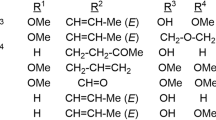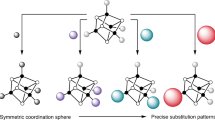Abstract
CUBANE-TYPE clusters containing the unit M4A4 have been the subject of many investigations. Several of these systems have been characterised by X-ray structure determination. Such clusters are important from a bioinorganic point of view, for example, Fe4S4 clusters in iron–sulphur proteins1. From a catalytic point of view, clustered compounds are becoming increasingly important as models for heterogeneous catalysts, and even as catalysts by themselves2. Monoatomic ligands (for example, A = S, Cl, P, Br, Se) have been reported as bridging ligands in cubane-type clusters, but larger groups are known in which C, N, and O act in a similar way3. No cubane-type clusters have been previously reported with the highly electronegative F− ion as a bridging ligand. We describe here the synthesis and structure of the first fluoro-bridged cubane-type cluster, having the formula [M4F4(L)12.] (BF4)4, in which M = Mn, Cd, Co and L = N-ethylimidazole or N-propylimidazole. On reaction of M(H2O)6 (BF4)2 in ethanol–triethyl orthoformate with an ethanolic solution of the ligand, finely-divided white powders (Mn, Cd) or purple crystals (Co) separate, analysing as M(ligand)3BF5. In these circumstances the F− ions are spontaneously generated by a slow decomposition of the BF4− ion. Such a decomposition of tetrafluoroborates, yielding fluoro complexes, has been reported in a few other cases, yielding polymeric fluoro-bridged systems4, dimers (M2F2)5 and also monomers MF2 (ligand)4 (ref. 6).
This is a preview of subscription content, access via your institution
Access options
Subscribe to this journal
Receive 51 print issues and online access
$199.00 per year
only $3.90 per issue
Buy this article
- Purchase on Springer Link
- Instant access to full article PDF
Prices may be subject to local taxes which are calculated during checkout
Similar content being viewed by others
References
Holm, R. H. Endeavour 34, 38–45 (1975).
Demitras, G. C. & Muetterties, E. L. J. Am. chem. Soc. 99, 2796–7 (1977).
Bertrand, J. A. & Eller, P. G. Progr. inorg. Chem. 21, 29–53 (1976).
Guichelaar, M. A., van Hest, J. A. M. & Reedijk, J. Inorg. nucl. Chem. Lett. 10, 999–1004 (1974).
Jansen, J. C. & van Koningsveld, H. Cryst. Struct. Commun. 5, 441–445 (1976).
Smit, S. & Groeneveld, W. L. Inorg. nucl. Chem. Lett. 11, 277–80 (1975).
Babel, D. Z. Anorg. Allg. Chem. 369, 117–30 (1969).
Clarke, P. J. & Milledge, M. J. Acta Crystallogr. B31, 1543–53 (1975).
de Jongh, L. J. & Block, R. Physica 79B, 568–93 (1975).
Author information
Authors and Affiliations
Rights and permissions
About this article
Cite this article
JANSEN, J., VAN KONINGSVELD, H. & REEDIJK, J. The first cubane-type fluoro-bridged cluster. Nature 269, 318–319 (1977). https://doi.org/10.1038/269318a0
Received:
Accepted:
Published:
Issue Date:
DOI: https://doi.org/10.1038/269318a0
This article is cited by
-
The coordination chemistry ofN-vinylimidazole
Transition Metal Chemistry (1982)
Comments
By submitting a comment you agree to abide by our Terms and Community Guidelines. If you find something abusive or that does not comply with our terms or guidelines please flag it as inappropriate.



